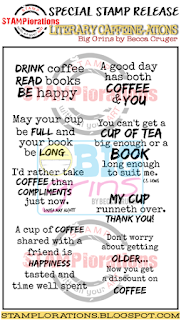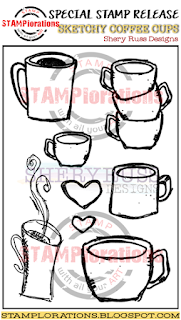Welcome, Friendly Friends to the very
first episode of the BS Sessions!
What are the BS Sessions?
Well Samantha knows how to work a marker like nobody's business and Becca loves to get messy with mixed media. We both wanted to learn the other person's crafty secrets so we're going to ask one another a question on the last Thursday of the month. Becca will provide you with some amazing Mixed Media techniques and Samantha will show you some tips and tricks about coloring! We'll both provide our followers with a little tutorial, because if we have these questions - our followers might too!
----------
Which brings me to this month's question, asked by Sammy:
How do you get your stencils to create such clean
lines with no bleeding?
Well now, this poses a conundrum because I usually just do a bunch of messy junk on my cards and I wasn't aware that I produced clean lines. ;)
Hah!
But seriously, there are a couple of tricks to using a stencil and getting the result you want. I'm going to take you through 3 different types of mediums and how to get a *kinda* clean line.
>>>>Stencils and Sponging with Distress Inks<<<<
So these tips really will work with any type of ink. I just said Distress Inks because, well, Damsel of Distressed... ya know?
First of all, I think this photo is wicked cool. The design lines are TOTALLY going to inspire a card in the future.
Step one of getting a good impression from stencil and sponging: TAPE IT DOWN!
For this, I like to use washi tape that I don't like very much because it's repositionable and won't rip my cardstock when I remove it. You will notice that I have two different rings of tape, one that's holding each side of my stencil down, and then another that's keeping my cardstock in place. That's because if you only tape down one, and the other still is movable, you're not going to get clean lines.
Step 2 - Be gentle but firm
Rub your sponge in soft circles, and always start from an edge/off the paper. That way you won't get weird stop/start lines. Use your free hand to hold the stencil down - moving your hand as you go along. If you rub too hard, you're likely to tear the stencil. If you rub too soft, you're likely to not get a good amount of ink onto the paper. Practice until you get a feel for it.
At this point, you could lift up your stencil and you'd have a nice impression. If you're sponging, I'd recommend wiping your hands on a wet towel, then peeling so that you don't accidentally get ink onto the white space.
For me, I added another layer to this.
>>>>Stencils and Embossing Paste<<<<
I kept the stencil positioned, exactly like I had it.
So Step 1 - TAPE IT DOWN!
Step 2 - Use a Palette Knife to Spread
Using a palette knife is the easiest way to pick up a good amount of texture paste, and then spread it over your surface. You want enough to cover the whole opening, and you can add more as you go along so don't grab a huge glob at first.
Different brands of texture paste have different consistencies. I really like the Ranger Art or Wendi Vecchi brands, myself but I've tried Dreamweaver brands and that is nice, as well. Texture paste usually has the consistency of shaving cream and is fairly easy to manipulate.
There are many different colors of texture paste. Here, I'm using a translucent/transparent version. It had a slightly jelly-like consistency.
Step 3 - Smooth it with the Flat End of the Palette Knife
Here it is all smoothed out. You can see that there is not many bumps and lumps in mine. If you want bumps and lumps, feel free to vary the pressure of the palette knife as you're smoothing and leave some areas with thicker paste and some areas with thinner paste.
Step 4 - Remove the Tape and Peel Back Carefully
Voila! Clean lines! Again, it's important to clean your hands before you peel back the stencil to help your chances of being smudge-free!
Another tip for texture paste, If you DO get some out of the lines - don't worry. Clean your palette knife and use it to remove the excess paste. It usually will come right off. But do it quickly - some brands of texture paste can dry very fast.
>>>>Stencils and Distress Spray Stains<<<<
Again - this could be any type of spray stain, really. I just only own Distress Spray Stains.
I started this background by sponging in 3 layers of Distress Inks to create a color blend.
ooooo- purty!
Then repeat
Step 1 - Tape it Down!! (are you getting the hint yet)
Step 2 - Spray your Ink then Dab with Paper Towel
Here's the deal folks, I'm sorry to break it to you but I don't really think there is a way to get CLEAN lines by using sprays and stencils. (maybe some other crafty magical genius can overrule me on this)
But there are a few tricks to getting CLEANER lines. - Dabbing up the excess with a paper towel helps to prevent seepage when you remove the stencil. You want to do this as quickly as possible.
Step 3 - Use a pen in a matching color to define lines
I bet you can tell which triangles I traced around! Here I'm using a Faber Castell Pitt Artist pen to go around the edges. It's a little time consuming, but that's the only real way to get semi-clean lines that I know of with this type of medium.
So there you have it Sammy! I hope this answered some of your questions! :)
I bet my readers are curious what question I asked Sammy! It is:
How do you blend skin tones so easily?


















































